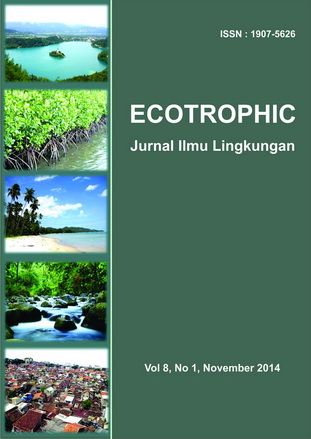EFEKTIVITAS SISTEM BIOFILTER AEROB DALAM MENURUNKAN KADAR AMONIA PADA AIR LIMBAH
Abstract
The increasingpopulationand activity of the Balinese people can increase the amount of waste as a byproduct of community activities. The presence of the metabolites in wastewater as ammonia is toxic to aquatic organisms. Application aerobic biofilter system can be used as an attempt to reduce levels of ammonia. In the aerobic biofilter, contact between the gravel media with microorganisms that form biofilmsare able to accelerate the degradation of organic matter and nitrification processes. The aims of this research are to determine the best consortium of activated sludge to reduce ammonia levels by aerobic biofilter system and to determine the effectivity of aerobic biofilter system. The first stage of this research were seeding of activated sludge from three sources are Wastewater Treatment Plan (WWTP) of Suwung Denpasar, WWTP of Wangaya Hospital and WWTP of Bali Tourism Development Corporation (BTDC) Nusa Dua Bali, for six days. This research was done by measuring Volatile Suspended Solid (VSS) value that showed the growth rate of biomass in activated sludge. The second stage wereapplication of activated sludges and control in aerobic biofilter to reduce ammonia levels, for five days. This study used a Completely Randomized Design with four treatments and three repetitions. The results showed that the best activated sludge obtained from WWTP of Suwung Denpasar indicated by the highest biomass growth (VSS value) of 2396.6 mg/L and was able to reduce ammonia up to 0.78 mg/ L. The effectivity of aerobic biofilter system with activated sludge from WWTP of Suwung Denpasar achieve effectivity of treatment process up to 92.20 % and have been able to pass the effectivity of quality standards (90%) during five days of processing. The effectivity levels was the highest compared to control and activated sludgetreatments.Downloads
Download data is not yet available.
How to Cite
INDRA WAHYUNI, Ni Made; BUDIARSA SUYASA, I Wayan; MAHARDIKA, I Gede.
EFEKTIVITAS SISTEM BIOFILTER AEROB DALAM MENURUNKAN KADAR AMONIA PADA AIR LIMBAH.
ECOTROPHIC : Jurnal Ilmu Lingkungan (Journal of Environmental Science), [S.l.], v. 8, n. 1, p. 79 - 85, june 2015.
ISSN 2503-3395.
Available at: <https://ojs.unud.ac.id/index.php/ecotrophic/article/view/13196>. Date accessed: 25 apr. 2024.
Issue
Section
Articles
Keywords
Effectivity; Aerobic Biofilter; Ammonia; Activated Sludge


